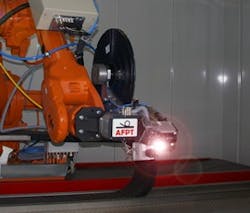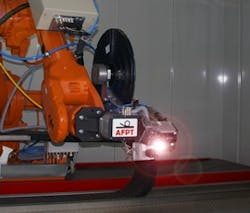Diode lasers used in tape manufacture
Dörth, Germany - The company AFPT, situated in the Netherlands and Germany and founded in 2003, saw a market need for lightweight materials that remain strong, and it developed a technology based on fiber reinforced thermoplastic composites. The company builds new, innovative products made from a single string of tape. Together with several renowned knowledge institutes, AFPT has designed and built several types of tape placement heads which have been integrated in robotized laser welding cells built by AWL. AWL, looking for new ways to help its customers with their production processes decided to take a 25% shareholder’s stake in AFPT.
The systems are fully automated and can handle products with a maximum length of 3000 mm and a width/diameter of 1500 mm. This technology can be used for tape winding and tape placement applications, in which case the winding mandrel is replaced by a mold and the robot moves along the mold.
Industries, such as aerospace, oil/gas exploration and automotive, are looking for new ways to reduce the weight of critical structures using environmentally friendly materials. However, the stiffness and strength of the complete structure remains a key factor. Nowadays, lightweight materials, such as aluminium and thermoset composites, are widely used. Formula 1 cars, for example, are almost entirely made of thermoset composites. The downside of fibre reinforced thermoset is that the production process is rather complex (multiple steps) and takes a long time. It is difficult to automate in a constant production flow.
In comparison to thermoset composites, thermoplastics offer a few advantages because they can be less brittle and faster to process as there is no curing required. AFPT uses a (diode) laser to heat and melt the thermoplastic resin. Using a laser offers many benefits in controlling the supplied amount of energy, and it makes for an accurate well-controlled process. The tape is pressed on the previously placed layer with a consolidation device. For aerospace applications, some customers still use autoclaves to reduce internal stresses when they use specific high-temperature materials.
Laser technology provides the highest energy density and efficiency in the welding zone combined with fast response times. This makes accurate control of the supplied energy possible (response time of only a few milliseconds). Overheating the tape can be avoided by taking the local tape temperature as the variable controlling the output.
Thermoplastic composites comply with the three major drivers: thermoplastic composites can be up to 4-6 times lighter than more traditional materials such as steel or aluminium, thermoplastic materials do not erode or rust and thermoplastic composites can be recycled.
The constitution of the tape depends on the kind of product and the demands of that product. However, this technology offers endless possibilities with just one solution. Mass production is also possible with the use of thermoplastic composites due to the fact that only one process step is necessary.
Besides being used in the manufacturing of large structural parts, thermoplastics will be introduced in a wide range of products, such as seals, pressure vessels and pipelines for various applications. The use of thermoplastics has proven to be very effective, especially in hostile environments, even under the toughest conditions. Although it will probably take another decade before aeroplanes are completely constructed from fibre reinforced thermoplastics, there are already some very promising tests being carried out.
For more about fiber reinforced thermoplastics, contact Coert Kok at AFPT.

